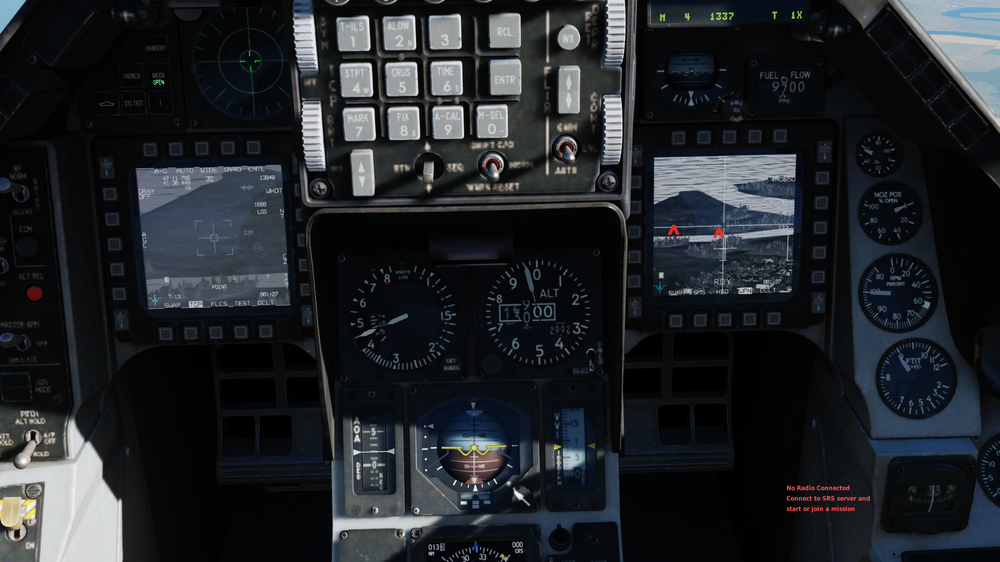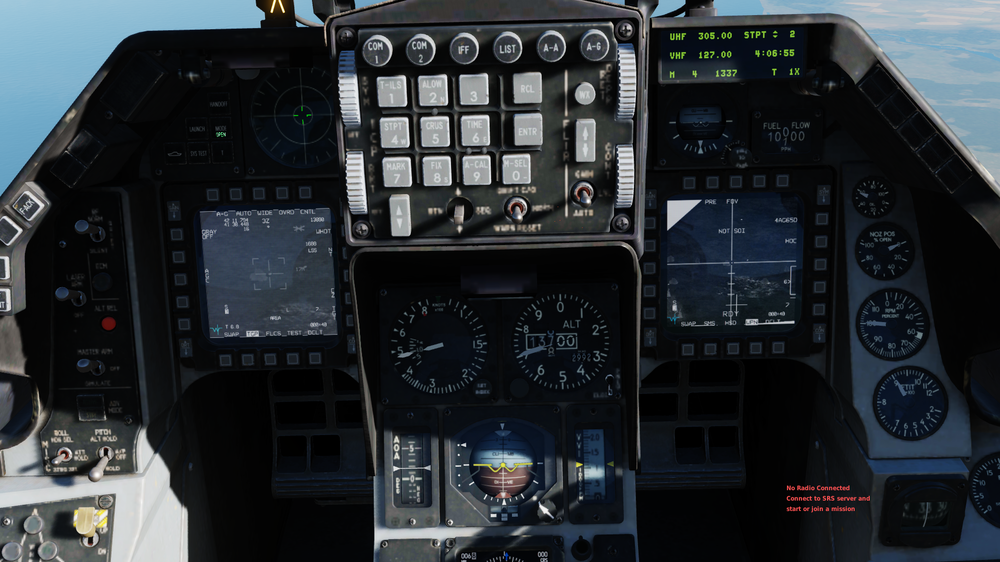

fudabidu
Members-
Posts
284 -
Joined
-
Last visited
Content Type
Profiles
Forums
Events
Everything posted by fudabidu
-
This is why I was talking about MASTER and SLAVE. The TGP isn't sending information directly to the Maverick. The plane takes the information, does some math and passes instructions to the Maverick.
-
It depends on your monitor refresh rate. 50hz = 50fps. 60hz = 60fps. 144hz = 144fps or 72fps (half). 60hz just happens to be a very common refresh rate. 30fps would be fine most of the time, but in a dogfight you want at least 50 or 60fps. It makes spotting and tracking targets much easier, especially over cluttered areas like forests or cities. What you should do is: check your monitor refresh rate setting (somewhere in the Windows display settings) enable V-sync for DCS play a mission and watch the FPS counter (iirc: LCTL + Pause) FPS should always be equal to the refresh rate adjust graphic settings as needed
-
Sorry to be blunt, but you're wrong. If TGP and plane weren't aligned, how can the TGP be slaved to a waypoint accurately? It can't! The whole system works based on simple trigonometry. The plane knows its own position and the position of the steerpoint. It then calculates a vector and sends that to the TGP. "Hey TGP, could you look 20° to the right, 30° down, please?" ... if the TGP is misaligned by just 1° it will look in the wrong direction. It's exactly the same issue as with Mavericks before boresight. Same the other way around when creating mark points (not implemented yet): TGP knows the angle and distance and sends it to the plane. If there is a misalignment the plane will use incorrect numbers for its calculation and store faulty coordinates. That's why the TGP (and MAVs) are supposed to be boresighted. The plane knows about any misalignments and can account for them. This is what makes the whole system accurate and useful! The plane is the MASTER, the brain of the system. It tells every other sensor / weapon what to do. Every other system is SLAVEd to this. The TGP and Mavericks are SLAVEs. They exchange data with the MASTER. In general a SLAVE will not directly communicate to another SLAVE So, a TGP -> MAV handoff looks a bit like this on the system side: TGP sends directions to the plane plane converts this into GPS coordinates (SPI) via basic trigonometry (accounting for TGP misalignment) plane converts SPI into directions for the Mavericks, using trigonometry (accounting for MAV misalignment) Image comparison between TGP and MAV sensor + fine adjustments command MAV lock, only in AUTO You see the system has to account for misalignment twice. Without aligning (aka boresighting) this wouldn't be possible. The AAQ-28 (supposedly) just happens to do that automatically via its own INS.
-
Can't find the manual in a reasonable time, but kept coming across this line: "An on-gimbal inertial navigation sensor establishes line-of-sight and automatic boresighting capability." So, I'd assume the TGP boresights itself by exchanging INS information with the plane during TGP startup or there is a DED menu for it. The Maverick doesn't have such an INS, hence the manual boresight procedure.
-
We know what you want, but it works differently in DCS. Go into the control options and click on "Modifiers" on the bottom. Click "Add" and set up the button you want to use for the shift function. Press the button while mapping controls and the modifier will be added.
-
When boresighting you're not aligning the Mavericks to the TGP, you're aligning them to the whole plane. You can also boresight in VIS using the HUD, but most people tend to do it with the TGP. The SOI shouldn't matter at all. In practice the plane takes a known location and only tells the Maverick which direction to look. Boresighting makes sure the plane is sending the correct directions. Without it you would always get the same offset, regardless of which SOI is used.
-
The pilot does it in the air, preferably at maximum possible range. On the ground you can't get the required view range (obstacles, terrain, etc), you'd get parallax errors and the Mavericks wouldn't align properly with the HUD and TGP. These errors aren't modeled yet, but that's probably going to change at some point. https://forums.eagle.ru/topic/258806-maverick-bore-sighting-is-always-perfect/?tab=comments#comment-4539578
-

Auto pitch, alt and bank to not engage on take off
fudabidu replied to KiwiOz's topic in Bugs and Problems
My bet is also on Hover Hold. Below 10 meters (radar altitude) it will disable the Pitch, Bank and Heading AP channels. Hover Hold needs to be disabled before the AP channels can be reengaged. Other than that: INU power, generators on, RPM to auto. -
This is hilarious. I can only imagine a Steam player who only owns FC3. Probably only flying casually on Aerobatics Online and feeling left out when the F-14 and F/A-18 players are having fun with the SC module. Why else would somebody buy a module blind even if basic logic dictates it's not going to work?
-

cannot reproduce Maverick hits short - what am I doing wrong?
fudabidu replied to wraith70's topic in DCS: F-16C Viper
Ripple firing has nothing to do with the problem shown in this track. The screenshot was taken from the track, approximately from the same direction as your plane. The Maverick's (wide) LOS hits the tower in front of the BTR and starts tracking that. -

cannot reproduce Maverick hits short - what am I doing wrong?
fudabidu replied to wraith70's topic in DCS: F-16C Viper
It's an issue with how optical sensors work in DCS. To put it simply: when commanding a lock (either manually or through handoff) the Maverick will cast a ray (aka. draw a line) along its LOS. This ray has a certain width to allow for some error, so the Maverick will still snap to the target. In this example there is a light tower in the way. The ray hits the tower first and the Maverick slews over to the wrong target. It gets much worse with vehicles on the road, because you'll often have street lights in the way, which you can't even see on the WPN page (using IR). This really needs an overhaul, especially with the increased object density on maps like Syria. Would be nice if that would be part of the promised "FLIR improvements", but I doubt we'll get any information on that ... like usual. -
@impreza The Ka-50 we got right now is modeled after #25 from 2000-2003. In order to model a new variant ED would need certain documentation, which is prohibited by the new law. Why is this so hard to understand? If you don't care about realism and just want Iglas, play EECH or something.
-
Well, I could see the load spinning. It was right in front of my canopy, so there was some kind of feedback. However, there wasn't anything I could do about it. I slowed down to a crawl and it didn't seem to affect the load at all.
-
Since when has there been an invisible FARP object? o.0 What are the exact dimensions of the FARP?
-
Oilfield mission 8 - ferry 4 cargos (barrels, oil tank, logs and pipes) Barrels and oil tank worked fine. Logs and pipes seemed to have no weight at all and spun around the aircraft until the rope snapped.
-
"This configuration [3 MAV on LAU-88] placed very high stress on the airframe and the inboard missile's exhaust impinged on the horizontal tail, causing the Air Force to restrict that load except in wartime."- Found in another forum, but with no replies to confirm or deny. Does sound reasonable to me though.
-
Or more importantly: "To accomplish missile boresight LAU-117/A launcher is required" That's the single launcher. What about the LAU-88? No boresight, no handoff I assume. You wouldn't even need to bother with boresighting anymore! Sorry, I find that thought hilarious. Now imagine ED also changed how the LAU-88 works on the A-10C.
-
@falconbr Highly appreciated. Confirms exactly what I've been taught elsewhere.
-
Early access isn't supposed to cater to everybody. It's a chance to get your hands on a module early, test it and provide feedback to the devs. You have to expect that many systems will be missing functionality, missing entirely or have bugs. If learning bugged systems is such a bad idea then people shouldn't buy early access modules, unless they already know how things are supposed to work or they are willing to dig through manuals. People would just learn the wrong things all the time, because the module isn't finished, right? Thank you. Does the manual also explain what boresighting does exactly? I'm under the impression it just aligns the MAV LOS with the TGP. When done at max range both lines of sight will be mostly parallel to each other, which is good enough to lock onto a target the size of a tank. Parallax would only be an issue at VERY close ranges when the angle between the LOSs increases significantly (way too close to launch anyways)
-
Not boresighting at all is different from doing it wrong and still having it work. Until the system is finished it's still good practice to do correctly.
-
That's exactly what I'm saying and I've just tested it again. See screenshots attached. bsgt1 was taken before boresighting. On the WPN page I marked the TGP target (left) and the MAV target (right). You probably need to zoom to make out the tiny white dots. bsgt2 was taken after commanding a handoff. MAV slewed over and locked onto the target without any issues. I repeated the process on the other pylon and got the exact same result.
-
Those are known enemy locations. Blue = enemy, Red = friendly (because Russia = red) If a group is set to visible in the ME it will show up on the ABRIS. Only the first unit in each group will be shown! The text next to it is the group's name (set in ME), but shortened. This information is ONLY updated when you enter the cockpit.
-
I intentionally did the boresight procedure wrong by locking two targets 800 meters apart. After commanding a hand-off the Mavericks aligned perfectly with the TGP. Because boresighting is supposed to be done in the air to maximize view range and minimize parallax errors.
-
The process of boresighting is realistic. Point track with TGP, lock same object with MAV, press BSGT, repeat for the other pylon. Since the SPI update (open beta) it works wonderfully. The mechanics aren't 100% realistic yet, but the process is.





